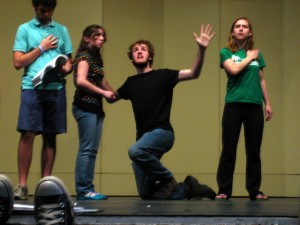
This week we had our 4th rehearsal of my new Christmas Play. Next Saturday is the dress rehearsal.
Sunday morning the show must go on.
The agenda at this point should be a “run-through”. That is, the cast should perform the play, start to finish, without interruption. Then I would make some comments on places to improve.
But putting on a play in a church is a lot different than in a community theater or high school.
- There are week-long gaps between rehearsals. Those delays do not allow the reinforcement that’s needed for each cast member to learn each scene, or to learn the play as a whole.
- There are inevitable absences. One time the Blessed Virgin Mary had a driver’s ed class. This week the angel Gabriel and King Herod were traveling, taking with them one Shepherd and one Wise Man.
We’ve never had a rehearsal with all the members of the cast present. It is a bit surreal, but the play is still taking shape.
I decided we needed to again work through the play slowly, piece by piece, making adjustments. Then, if we had time, we would do a run through.
This may have been a big mistake. I’ll keep you posted.
Initial Notes
I gathered the cast. We opened with prayer. I told him the agenda for the day. And then I gave them three specific instructions:
1. Meditate and pray on your lines.
The goal is to move from simply saying the lines as written, to feeling what the character is feeling.
They should aim to speak the lines as the person they are playing. That’s the difference between reading and acting.
To get there, I encouraged them to spend time every day in the coming week reading, meditating, and praying their own lines. It isn’t that my creative work on the play is so special. The special thing is that the lines they speak are all words from Scripture.
They need the those words to become part of their prayerful conversation with God, going deep into their hearts. Then when they speak their lines they will better embody the character’s feelings.
This is particularly important for those with lengthy speeches, like Zechariah and Mary. In each word or phrase of those ancient songs they need to know whether they are speaking to God, to an infant child, to an assembled crowd, to a relative, or to the audience.
2. Pick up your cues.
If there are pauses, even tiny pauses, between lines the play will drag. It will bore the audience instead of drawing them into the story.
The solution is, in the language of the theater, to “Pick up your cues.” They should listen for the very last word of the line that cues their own, and start speaking their line as that cue word is being spoken.
The only exceptions are when a pause adds to the meaning and expresses the feeling.
3. Think about the character’s changing feelings.
Then I did something I probably wouldn’t do if I was directing a play in a community theater: I told them what I thought each character was probably feeling.
With experienced actors I would want to let them find the feelings and motivations of their characters on their own.
In a church play the cast members may have been drafted rather than volunteering. They may not be drawn to acting at all. So I decided to briefly name some feelings and motivations for them to think about as they rehearsed and prepared.
(I’ll put those notes in another post later this week.)
Run-Through
So what should have been a run-through became a walk-through. We took it piece by piece. We reinforced and improved on blocking and the interpretation.
We used the rest of the time to go back and rehearse sequences where a lot of movement was required.
Most importantly, we went over the scenes with the children several times. Getting groups of angels and shepherds and magi in the right places at the right times take some repetition.
I realized, for instance, that our shepherds tended to mill around trying to find a place to sit down. We practiced by choosing a specific place for each child in advance, and moving straight to that spot.
We also worked on lines spoken in unison, especially when this included the children. I would speak the line phrase by phrase and have them repeat after me. Then I would give them the cue and have them speak it all together.
I’ll confess I’m anxious that we haven’t actually done a regular run-through. But it is really exciting to see all the pieces coming together!
————
This post is part of a series. To go to the start, click here. To go to the next, click here.

It will be really cool if, on the Sunday when you perform, someone is recruited to video the production for you to share the finished product with us. 🙂
Thanks Claudia! I’ll see if I can make it happen. I’m so glad you are interested!
Blessings,
Gary